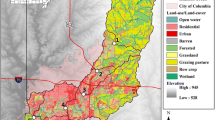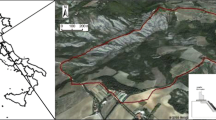Abstract
Competing influences of climate, watershed characteristics, and human activities can confound classic hydrologic process assumptions and, therefore, management efforts in mixed-land-use watersheds. Seven water years (WY2009–2015) of sub-hourly rainfall and stream flow data were collected from five nested gauging sites in a mixed-land-use watershed of the central USA. Pasture/cropland use decreased by 18% while urban land use increased by 22% from the headwaters to the watershed outlet. A flow separation algorithm was used to assess rainfall–stream flow response variables (i.e. stream flow, event flow and base flow) at each gauging site and at multiple time steps (7-year study, annual, monthly, event based). Annual total rainfall ranged from 678 to 1610 mm during the study period. Urban land use explained 61–93% of the variance in the slope of the best fit line between total rainfall and stream flow, event flow, and base flow confirming significant (CI = 95%; p < 0.006; n = 5) impacts of urban land use on rainfall–stream flow response relationships. Total stream flow, event flow and base flow increased by 101, 95, and 110%, respectively, at the rural/urban interface of the watershed during a year of extreme drought. Base flow index values were positively correlated with urban land use and negatively correlated to total rainfall (R2 = 36.98; p < 0.023; n = 111). Stream flow alterations were greatest during drier years, and during smaller flow events at gauging sites with greater than 6% urban land use. Results advance quantitative understanding of rainfall–stream flow relationships for urbanizing mixed-land-use watersheds.





Similar content being viewed by others
References
Allan JD (2004) Landscapes and riverscapes: the influence of land use on stream ecosystems. Annu Rev Ecol Evol Syst 35:257–284
Allen PM, Harmel RD, Arnold J, Plant B, Yelderman J, King K (2005) Field data and flow system response in clay (vertisol) shale terrain, north central Texas, USA. Hydrol Process 19(14):2719–2736
Archer D (2003) Scale effects on the hydrological impact of upland afforestation and drainage using indices of flow variability: the River Irthing, England. Hydrol Earth Syst Sci Dis 7(3):325–338
Brown AE, Zhang L, McMahon TA, Western AW, Vertessy RA (2005) A review of paired catchment studies for determining changes in water yield resulting from alterations in vegetation. J Hydrol 310(1):28–61
Changnon SA, Demissie M (1996) Detection of changes in stream flow and floods resulting from climate fluctuations and land use-drainage changes. Clim Change 32(4):411–421
Chapman T (1999) A comparison of algorithms for stream flow recession and baseflow separation. Hydrol Process 13(5):701–714
Coe MT, Latrubesse EM, Ferreira ME, Amsler ML (2011) The effects of deforestation and climate variability on the stream flow of the Araguaia River, Brazil. Biogeochemistry 105(1):119–131
Cohen JE (2003) Human population: the next half century. Science 302(5648):1172–1175
Dottori F, Martina MLV, Todini E (2009) A dynamic rating curve approach to indirect discharge measurement. Hydrol Earth Syst Sci 13(6):847
EPA (2017) National summary of state information. https://ofmpub.epa.gov/waters10/attains_nation_cy.control#status_of_data. Assessed Aug 2017
Homer CG, Dewitz JA, Yang L, Jin S, Danielson P, Xian G, Coulston J, Herold ND, Wickham JD, Megown K (2015) Completion of the 2011 National Land Cover Database for the conterminous United States-representing a decade of land cover change information. Photogramm Eng Remote Sens 81(5):345–354
Hooper LW (2015) A stream physical habitat assessment in an urbanizing watershed of the Central USA. Master’s thesis. University of Missouri, Columbia
Hubbart JA (2011) Urban floodplain management: understanding consumptive water-use potential in urban forested floodplains. Stormwater 12(6):56–63
Hubbart JA, Zell C (2013) Considering stream flow trend analyses uncertainty in urbanizing watersheds: a baseflow case study in the central United States. Earth Interact 17(5):1–28
Hubbart JA, Link TE, Gravelle JA, Elliot WJ (2007) Timber harvest impacts on water yield in the continental/maritime hydroclimatic region of the United States. For Sci 53(2):169–180
Hubbart JA, Holmes J, Bowman G (2010) Integrating science based decision making and TMDL allocations in urbanizing watersheds. Watershed Sci Bull 1:19–24
Hubbart JA, Muzika R-M, Huang D, Robinson A (2011) Improving quantitative understanding of bottomland hardwood forest influence on soil water consumption in an urban floodplain. Watershed Sci Bull 3:34–43
Hubbart JA, Kellner E, Hooper L, Lupo AR, Market PS, Guinan PE, Stephan K, Fox NI, Svoma BM (2014) Localized climate and surface energy flux alterations across an urban gradient in the Central U. S. Energies 7:1770–1791
Jacobson CR (2011) Identification and quantification of the hydrological impacts of imperviousness in urban catchments: a review. J Environ Manag 92(6):1438–1448
Jennings DB, Jarnagin ST (2002) Changes in anthropogenic impervious surfaces, precipitation and daily stream flow discharge: a historical perspective in a mid-Atlantic subwatershed. Landsc Ecol 17(5):471
Jones JA, Grant GE (2001) Comment on “Peak flow responses to clear-cutting and roads in small and large basins, Western Cascades, Oregon: a second opinion” by RB Thomas and WF Megahan. Water Resour Res 37(1):175–178
Kellner E, Hubbart JA (2017) Confounded by forgotten legacies: effectively managing watersheds in the contemporary age of unknown unknowns. Hydrol Process. https://doi.org/10.1002/hyp.11223
Konrad CP, Booth DB (2002) Hydrologic trends associated with urban development in western Washington streams. U.S. Geological Survey Water Resources—Investigations Report 02-4040, pp 40
Konrad CP, Booth DB (2005) Hydrologic changes in urban streams and their ecological significance. In: American Fisheries Society symposium, vol 47, pp 157–177
Konrad CP, Booth DB, Burges SJ (2005) Effects of urban development in the Puget Lowland, Washington, on interannual stream flow patterns: consequences for channel form and streambed disturbance. Water Resour Res 41(7):1032
Leopold LB (1968) Hydrology for urban land planning: a guidebook on the hydrologic effects of urban land use. US Geol Surv Circ 554:298–448
Leopold LB, Wolman MG, Miller JP (2012) Fluvial processes in geomorphology. Courier Corporation, North Chelmsford
Lerch RN, Baffaut C, Sadler EJ, Kremer RJ (2015) Long-term agroecosystem research in the Central Mississippi River Basin: goodwater creek experimental watershed and regional herbicide water quality data. J Environ Qual 44(1):28–36
Lewis J, Mori SR, Keppeler ET, Ziemer RR (2001) Impacts of logging on storm peak flows, flow volumes and suspended sediment loads in casper creek, California. In: Wigmosta MS, Burges SJ (eds) Land Use and Watersheds: Human Influence on Hydrology and Geomorphology in Urban and Forest Areas. American Geophysical Union, Washington, DC, pp 85–126
Li LJ, Zhang L, Wang H, Wang J, Yang JW, Jiang DJ, Qin DY (2007) Assessing the impact of climate variability and human activities on stream flow from the Wuding River basin in China. Hydrol Process 21(25):3485–3491
Ma Z, Kang S, Zhang L, Tong L, Su X (2008) Analysis of impacts of climate variability and human activity on stream flow for a river basin in arid region of northwest China. J Hydrol 352(3):239–249
McIntyre N, Al-Qurashi A, Wheater H (2007) Regression analysis of rainfall–runoff data from an arid catchment in Oman. Hydrol Sci J 52(6):1103–1118
Meyer SC (2005) Analysis of base flow trends in urban streams, northeastern Illinois, USA. Hydrogeol J 13(5–6):871–885
Miller DE, Vandike JE. 1997. Groundwater resources of Missouri, vol 2. Missouri Department of Natural Resources, Division of Geology and Land Survey, Missouri
NDMC (2013) How drought evolved from floods of 2011: from too much to too little. National Drought Mitigation Center. http://drought.unl.edu/Portals/0/docs/CentralUSDroughtAssessment2012.pdf. Assessed Aug 2017
Nichols J, Hubbart JA, Poulton BC (2016) Using macroinvertebrate assemblages and multiple stressors to infer urban stream system condition: a case study in the Central US. Urban Ecosyst. https://doi.org/10.1007/s11252-016-0534-4
Poff NL, Zimmerman JK (2010) Ecological responses to altered flow regimes: a literature review to inform the science and management of environmental flows. Freshw Biol 55(1):194–205
Poff NL, Richter BD, Arthington AH, Bunn SE, Naiman RJ, Kendy E, Henriksen J (2010) The ecological limits of hydrologic alteration (ELOHA): a new framework for developing regional environmental flow standards. Freshw Biol 55(1):147–170
Power ME (1995) Floods, food chains, and ecosystem processes in rivers. Linking species and ecosystems. Chapman and Hall, New York, pp 52–60
Price K (2011) Effects of watershed topography, soils, land use, and climate on baseflow hydrology in humid regions: a review. Prog Phys Geogr 35(4):465–492
Restrepo-Posada PJ, Eagleson PS (1982) Identification of independent rainstorms. J Hydrol 55:303–319
Schilling KE, Jha MK, Zhang YK, Gassman PW, Wolter CF (2008) Impact of land use and land cover change on the water balance of a large agricultural watershed: historical effects and future directions. Water Resour Res 44(7):142
Sun G, Zhou G, Zhang Z, Wei X, McNulty SG, Vose JM (2006) Potential water yield reduction due to forestation across China. J Hydrol 328(3):548–558
Thomas RB, Megahan WF (2001) Reply to “Comment on ‘Peak flow responses to clear-cutting and roads in small and large basins, Western Cascades, Oregon: a second opinion’ by RB Thomas and WF Megahan”. Water Resour Res 37(1):181–183
Walsh CJ, Roy AH, Feminella JW, Cottingham PD, Groffman PM, Morgan IIRP (2005) The urban stream syndrome: current knowledge and the search for a cure. J N Am Benthol Soc 24(3):706–723
Walsh CJ, Fletcher TD, Burns MJ. 2012. Urban stormwater runoff: a new class of environmental flow problem. PLoS One 7(9):e45814
Wang L, Lyons J, Kanehl P, Bannerman R (2001) Impacts of urbanization on stream habitat and fish across multiple spatial scales. Environ Manag 28(2):255–266
Wang L, Lyons J, Kanehl P (2003) Impacts of urban land cover on trout streams in Wisconsin and Minnesota. Trans Am Fish Soc 132(5):825–839
Winkler R, Spittlehouse D, Boon S (2017). Stream flow response to clear-cut logging on British Columbia’s Okanagan Plateau. Ecohydrology 10(2):e1836
Zhang YK, Schilling KE (2006) Increasing stream flow and baseflow in Mississippi River since the 1940s: effect of land use change. J Hydrol 324(1):412–422
Zhou G, Wei X, Luo Y, Zhang M, Li Y, Qiao Y, Wang C (2010) Forest recovery and river discharge at the regional scale of Guangdong Province, China. Water Resour Res 46(9):e09503
Acknowledgements
Funding was provided by the Missouri Department of Conservation and the U.S. Environmental Protection Agency Region 7 through the Missouri Department of Natural Resources (P.N: G08-NPS-17) under section 319 of the Clean Water Act and through joint agreement of the University of Missouri, the City of Columbia, and Boone County Public works and partners of the Hinkson Creek Collaborative Adaptive Management (CAM) program. Additional funding was provided by the National Science Foundation under Award Number OIA-1458952, the USDA National Institute of Food and Agriculture, Hatch project accession number 1011536, and the West Virginia Agricultural and Forestry Experiment Station. Results presented may not reflect the views of the sponsors and no official endorsement should be inferred. Special thanks are due to many scientists of the Interdisciplinary Hydrology Laboratory (http://www.forh2o.net).
Author information
Authors and Affiliations
Corresponding author
Ethics declarations
Conflict of interest
The authors declare no conflicts of interest.
Rights and permissions
About this article
Cite this article
Zeiger, S.J., Hubbart, J.A. Rainfall–stream flow responses in a mixed-land-use and municipal watershed of the central USA. Environ Earth Sci 77, 438 (2018). https://doi.org/10.1007/s12665-018-7630-0
Received:
Accepted:
Published:
DOI: https://doi.org/10.1007/s12665-018-7630-0




